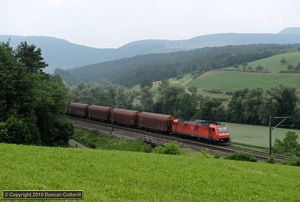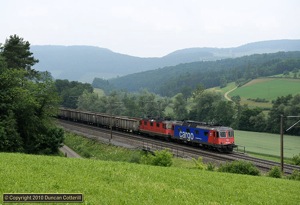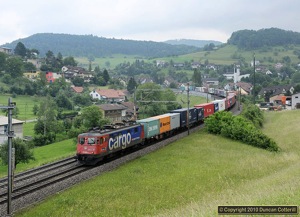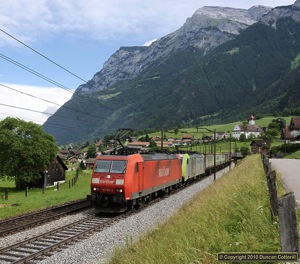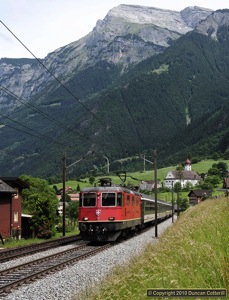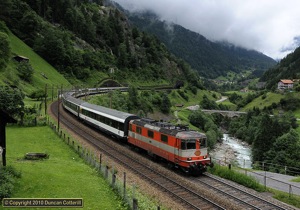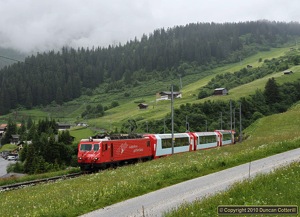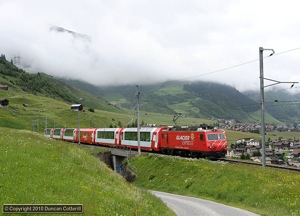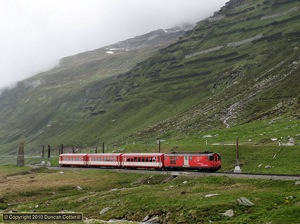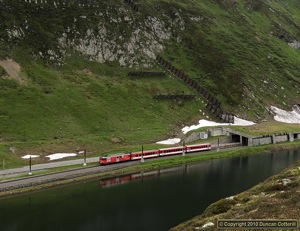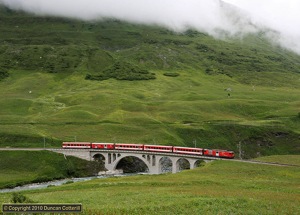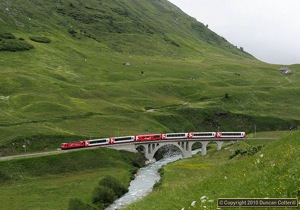Monsoon In The Alps
15 - 20 June 2010
Report by Duncan Cotterill
Introduction
After ten years a return to the Gotthard Pass was long overdue. The Gotthard is one of Europes busiest freight routes, carrying heavy traffic between Germany and Italy through the heart of the Swiss Alps. While in Switzerland, I also followed a tip off that there were some worthwhile photo positions around Frick on the Basel - Zürich line and had a look at the MGB’s metre gauge line around Andermatt and the Oberalp Pass.
This report is divided into two parts: This page contains a summary of the trip. The Day by Day section contains details of each day’s activities, trains seen, travel, hotels etc.
The Bözberg Route
I spent my first day in Switzerland around Frick on the Basel - Zürich main line, or to be more specific, the northerly route via the Bözberg Tunnel. The line follows the Rhein east from Basel to Stein then turns to the south-east and climbs up Fricktal to the Bözberg Tunnel under the mountain of the same name. On the east side of the tunnel, the line follows the Aare Valley to Brugg, giving access to the line east along the Limmat Valley to Zürich or the freight route south via Lenzburg and Rotkreuz towards the Gotthard Pass.
Passenger Services
The passenger service on the line consists of two trains each way an hour between Basel and Zürich. Destinations at the Zürich end alternate between HB and Flughafen. Other trains between Basel and Zürich run via Liestal and Aarau, so weren’t seen. The Flugzüge, as the trains to/from Zürich Flughafen are known, were all worked by class 460s on push-pull sets of all sizes and shapes. the locos were consistently at the Zürich end of the formations. The trains to/from HB were a mixture of one third 460s at the Zürich end of push-pull sets and two thirds Re4/4iis on hauled stock. Only one unit was seen east of Frick, a class 521 Flirt heading east ECS in mid afternoon. Similar units were seen in the distance working stopping trains between Frick and Basel. One unexpected working seen was DB 103.184 heading towards Zürich in the early afternoon, hauling a matching set of red and cream coaches.
Freight Traffic
Most freights were worked by SBB Cargo locos, as expected, with Re4/4iis and Re6/6s predominating, often one of each paired as an Re10/10. There were also a few SBB Cargo 482s and a couple of Ae6/6s. Other operators were represented by two Crossrail 185s, two DB 185s (on separate trains), a BLS 486 and a TXL 189. In total 22 freights were seen during the day, around half of them intermodal services carrying containers and/or swap-bodies. The rest included several general freights and trains of new cars, oil tanks and scrap steel.
Photography
The weather was totally overcast all day with occasional light rain so I didn’t actually do a lot of photography. Most of the morning was spent a couple of km east of Frick, just watching the traffic and clocking up 25 movements in three hours, 12 passengers, the 12 freights mentioned above and one light engine. In the early afternoon I moved a few km further east to Zeihen and spent another three hours hoping in vain that the sun might come out. Traffic levels remained high with 26 movements observed, 12 passengers, 1 ECS, 1 special, 10 freights and 2 light engines.
If only the sun had been out, it would have been an excellent day. There were some acceptable morning positions around 2 km east of Frick station and some excellent afternoon shots around Zeihen, around 8km east of Frick. Although Zeihen doesn’t have a station, there are buses approximately hourly from Frick station (Table 50.139) however it appears that many require compulsory reservations! Buses from Brugg operate hourly to Effingen, around 2km from Zeihen (Table 50.137), and there are also hourly or half-hourly buses from Frick to Herznach, also about 2km from Zeihen (Table 50.135). Neither of these services appear to require reservations.
The Gotthardbahn
The Gotthardbahn is one of Europe’s busiest and most scenic main lines, running through the heart of the Alps from central Switzerland to the Italian border. It is one of Europe’s principal north - south freight routes, carrying heavy traffic, primarily between Germany and Italy, as well as international and Swiss domestic passenger trains. A wide variety of passenger and freight motive power can be seen including locos from DB and several independent operators.
The Gotthardbahn proper starts at Arth-Goldau where the passenger line from Zürich meets the double-track main line from Rotkreuz. This line carries passenger traffic from Basel, Olten and Luzern as well as freight traffic from the north, routed via the Lenzburg - Rotkreuz line. The mountain section starts 32km south of Arth-Goldau at Erstfeld (472m a.s.l.), from where the line ascends to an altitude of 1105m a.s.l. at Göschenen, 29 rail km to the south and at the northern end of the 15km Gotthard Tunnel. As the crow flies, the distance is nearer 20km but the crow doesn’t have the Gurtnellen Spiral or the horseshoe curves at Wassen to negotiate. The actual summit, at 1151m a.s.l., is just over halfway through the tunnel. From the southern portal near Airolio (1141m a.s.l.), the line descends to 330m a.s.l. at Bodio, 40km to the south, where the gradients ease again. From Bodio it’s another 80km to Chiasso and the Italian border.
Passenger Trains
The regular passenger service consists of hourly InterCity or EuroCity trains linking Basel with Lugano or Zürich with Milano and hourly InterRegio trains linking either Basel or Zürich with Locarno. The two services connect at Arth-Goldau so a Basel - Lugano IC connects with a Zürich - Locarno IR on even hours and a Zürich - Milano EC connects with a Basel - Locarno IR on odd hours. To complicate the issue, there is often a Zürich to Lugano IC running a couple of minutes ahead of the EC trains with exactly the same stopping pattern.
The domestic IC services are operated by Class 500 ICN tilting EMUs, sometimes in pairs, and the EC services are operated by Italian Class 470 tilting EMUs. Some of these carry SBB logos, presumably dating from the split-up of assets when the Cisalpino partnership was broken up. Irrespective of whether they have SBB or FS markings, they still have Italian numbers, without the check digit or the Swiss classification (RABe?). The IR services are more interesting, being formed of a motley collection of conventional stock usually including a first class panoramawagen and often a couple of Schierens as well, all hauled in both directions by Class Re4/4ii or class 460 locos. The relative numbers of each class varied considerably from day to day with Friday being very good for Re4/4iis.
A southbound VSOE was seen on 18 June, hauled by a pair of Re4/4iis.
Freight Traffic
Intermodal trains predominated during my visit with most conveying containers and/or swap bodies. RoLa (Rollende Landstrasse = rolling road) services conyeying complete lorry trailers were also seen but never more than one train a day. There were also conventional wagonload freights and a few block trains. Freight traffic levels were heavy with two trains each way per hour being fairly normal during the week. Four freights were seen in a two hour period on the Saturday afternoon, all of them southbound. Sunday was a little quieter but still produced five freights in just over three hours.
Motive power was quite varied. The most common traction was an SBB Cargo Re10/10 (an Re4/4 and an Re6/6 paired up) but various different combinations of up to four Re4/4 and/or Re6/6 were seen. Bankers were common with Re6/6 11677 doing much of the work but other Re4/4 or Re6/6 appearing as well. SBB Cargo Class 482 were fairly rare and Classes 474 and 484 didn’t appear at all.
The next most common class seen was DB Class 185, usually in pairs and often with a third Class 185 banking. DB Class 185s were also seen piloting BLS Class 486 locos on several occasions. The independent sector was represented by Crossrail class 186s, usually in pairs and sometimes with a Crossrail Class 185 banking, and TX Logistik Class 182s, usually piloted by an MRCE Class 189.
Photography
The Gotthard isn’t a particularly easy line to photograph. The line, old main road, Autobahn and multiple power lines are all squeezed into a narrow, steep-sided, rocky, wooded valley. For much of the way, the line is in tunnel or impossibly high up the side of the valley. Where the it is visible, it’s often isn’t accessible or it’s impossible to keep ugly power lines or the autobahn out of the shot. Even when everything else is right, the electrification masts are very closely spaced, leaving little room to fit a single engine between them, let alone a double-header. In spite of this, the line is still well worth visiting for the superb scenery, heavy traffic and variety of motive power. All this was a bit academic during my visit as the weather was never good enough for serious photography.
There are no local train services over the Gotthard but there are hourly buses between Erstfeld and Göschenen that take the old main road that follows the line closely (Table 60.401).
Matterhorn Gotthard Bahn
The Matterhorn Gotthard Bahn (MGB) was formed by the amalgamation of two of Switzerland’s principal metre gauge lines, the Brig Visp Zermatt (BVZ), running from Brig to Zermatt via Visp (surprisingly enough), and the more satisfactorily named Furka Oberalp (FO), running from Brig to Disentis via the Furka and Oberalp Passes. Both lines shared a common gauge, electrification system and rack system and much of the motive power and rolling stock was similar if not identical.
The sections of line I visited were centred around Andermatt. Lines radiate from the town in three directions; west towards the Furka Pass and Brig, north via a short and very steep connection to the SBB Gotthard main line at Göschenen and east over the Oberalp Pass and down into the Vorderrhein valley and an end on connection with the Rhätischebahn at Disentis/Muster. The line to the west, as far as the eastern portal of the Furka Base Tunnel at Realp, follows the Furkareuss Valley and is very pleasant but not particularly spectacular. The line to the north should be spectacular, dropping down a very steep, narrow gorge, but apart from very short sections at both ends it runs entirely in a reinforced concrete avalanche shelter.
That leaves the line to the east over the Oberalp Pass. The climb out of Andermatt is an engineering marvel and starts almost at the station throat where the rack is engaged. From then on it’s solid slog, climbing 407 metres in 4.5 km to Natschen by winding back and forth up the precipitous mountainside, with the views of the town and valley below improving with every turn. At Natschen the character of the line changes completely as it turns into a narrow valley, way above the tree line and continues to climb on the rack through barren upland scenery reminiscent of parts of the Scottish Highlands until it reaches the Oberalpsee at the summit of the Oberalp Pass, 2033m a.s.l. and almost 600m above Andermatt. After leaving Oberalppass station the line drops through a series of tunnels and avalanche sheds to Tschamutt. The remainder of the descent to Disentis alternates between adhesion sections across Alpine meadows and rack sections where the valley narrows and steepens. On this occasion I didn’t venture any further east than Dieni, 7.3km from Oberalppass and 580m lower down.
Passenger Trains
The Andermatt - Disentis and Andermatt - Brig lines are served by hourly all-stations passenger trains for most of the day, with a three hour gap in the middle of the day on the Disentis line to allow the passage of four Glacier Expresses in each direction. The Andermatt - Göschenen line has the luxury of two trains an hour, connecting with the southbound and northbound main line trains at Göschenen. Then there are the Glacier Expresses, running between Zermatt and St. Moritz or Davos. The summer service consists of three St. Moritz trains and one Davos train in each direction daily. The eastbound trains converge on Andermatt between 11:30 and 13:00 followed by the westbounds between 13:50 and 15:10.
Motive power for all the local passenger trains was provided by Class Deh4/4 motor luggage vans coupled to 3 coach push-pull sets with the motor coach usually at the east end of the set. On previous visits to the area I’d only seen the ex FO Deh4/4i and Deh4/4ii variants but this time a couple of the ex BVZ version were in use as well, coupled to the west end of their trains. The Glacier Express workings are usually formed of six panoramawagen in a special white and red Glacier Express livery, hauled by a Class HGe4/4ii loco. In winter there are fewer Galcier Express workings and most of the Andermatt - Disentis local trains are loco hauled.
Freight Traffic
As far as I’m aware, there is no regular freight traffic on any of the MGB lines around Andermatt, however, there are car-shuttles through the Furka Base Tunnel. One of these was seen at Realp, powered by Ge4/4 81, one of a class of two locos not fitted with rack equipment.
Photography
There are a few good photo positions on the line from Andermatt to Realp, particularly around the fine stone bridge a couple of km west of Hospental. The line to Disentis has many excellent locations, particularly on the climb out of Andermatt and around the Oberalpsee as well as a number of positions around Dieni, Sedrun and Segnas. Traffic levels are much less than on the Gotthard but the photo positions are a lot less cluttered. It’s just trains and scenery.
Comments
The trip was ruined by the appalling weather. Everything else worked out pretty well and there was certainly no shortage of traffic. With the recent reopening of the Monte Olimpino II Tunnel south of Chiasso and the partial closure of the Varzo tunnel on the parallel Simplon line, traffic levels on the Gotthard were very good. I’ll have to go back at least once more before the Gotthard Base Tunnel opens at the end of 2017.
The Bözberg line through Frick is not in the same league as the Gotthard as far as scenery is concerned but traffic levels are just as heavy and all the passenger trains are worked by locos, even if a good proportion are pushing. There’s also the added attraction of a handful of Ae6/6 workings and the proximity to Basel and Zürich, which makes adding a day at Frick to a trip elsewhere in Switzerland relatively easy. Definitely worth another visit.
The MGB is a real gem. Some might complain that the Motor Luggage Vans aren’t real locomotives but they photograph well and that’s what counts in a photo, obviously. I also love the wildness of the line, particularly around the top of the Oberalp Pass. Another place to go back to.
This report is divided into two parts: This page contains a summary of the trip. The Day by Day section contains details of each day’s activities, trains seen, travel, hotels etc.
